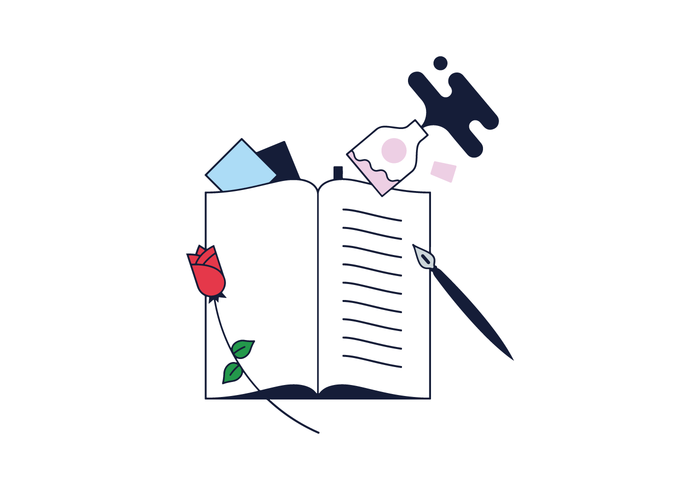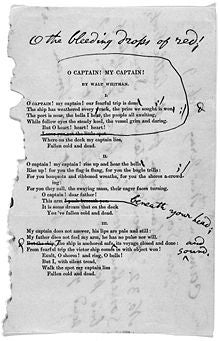In our last two writing genre series blog posts, I offered some tips on Graduate School Applications and Catharina discussed the conventions of Lab Report writing. Her upcoming genre topic will be Visual Arts Analysis and you can check it out on April 16th! In this writing genre instalment, on Poetry Analysis, I will provide pointers for poking and prying at poems to peruse and pick up on the poem’s pronouncements and purport.

If you are studying English, you may have an exam coming up that will involve poetry analysis, or you may be looking to analyze a poem for enjoyment or a deeper understanding of your for-pleasure reading materials. Whatever the reason for your upcoming analysis of a poem, don’t fear—it’s not as daunting as it may seem. As with poetry, you can explore the things that resonate with you (that being said, if your prof has asked you to focus on particular elements or ideas, be sure to follow the instructions). Rather than analyzing your experiences and emotions, poetry analysis involves looking at elements of the poem itself on a deeper level in order to make a particular argument about the poem or gain a deeper understanding. If the former is your goal, the latter will inevitably follow.
A Few Meaning-Revealing Elements to Consider:
Word Choice:
Pay attention to each word; since poems are condensed, poets tend to be very particular and careful in their choice of words. Certain words may be noteworthy because they bring something to mind, repeat themes or ideas, or have double meanings. There are many things that would make certain words worth mentioning or commenting on; it just depends on what your chosen focus is.
Be sure to look up words in a dictionary if you aren’t sure about their definition. Even if you think you know, looking words up is a great practice because you may discover another signification for the word or an interesting origin story that can put weight behind your thesis.
Visual Structure and Shape:
Look at the poem as a whole; think about what the poem looks like or reminds you of. Meaning can be found not only in the words of the poem but also in its shape. A good example of this is “The Mouse's Tale” from Alice's Adventures in Wonderland. This poem is about a mouse's tale (story) but also looks like a mouse tail. The poem also tunnels downward, reminding the reader of Alice falling down the rabbit hole. Also, “The Mouse’s Tale” ends with the word “death” so the tunnelling downward could be reminiscent of digging a grave. When considering the visual shape of the poem, look at the poem overall, but also consider the shape of individual sentences, words, or even letters.
Sound:
Try reading the poem out loud, as significance can be found in the sound as well. You may consider the sound of the meter of the poem or the sound of certain sentences or words. For instance, harsh consonants may be used to describe something unpleasant or unwieldy, while softer vowel sounds or liquid consonants may be used to express contentment. There are many other sound devices used in poetry that you can look for in the poem you’re analyzing.
“The Mouse’s Tale is written in a “tail rhyme” scheme, which is the same as “end rhyme,” in which the final syllables of each line of poetry rhyme. This rhyme scheme brings special attention to the sound and implications of the rhyming words.
Historical Background:
Unless you are told to apply the method of the New Critics and only focus on the poem itself, you can also take into account the historical/social/political circumstances at the time the poem was written. The social climate may provide you with a deeper understanding of the poet’s motives for writing the poem, as well as any allusions to historical events or figures that may be embedded in the poem.
For example, in “The Mouse’s Tale,” the mouse is sentenced to death by someone acting as both judge and jury; Lewis Carroll critiques illegitimate lawsuits and unfair trials. If analyzing this poem, you may want to take a deeper look at the legal system at the time or whether there were particular high-profile cases at the time that Carroll may have been commenting on.
Biographical information:
You can also consider the author’s life when analyzing a poem. For example, you could do some research on Carroll and his own personal experiences with the legal system… or mice? Perhaps he was arrested? Perhaps he was on a jury and was displeased with the outcome? Perhaps he was a mouse farmer? Although these queries are all just based on conjecture, they are examples of the kinds of things that could be looked into to better understand the poet and the poem.
These are just a few elements to consider when analyzing a poem; as with Carroll’s possible history of mouse farming, further research can (and probably should) be done to get a good understanding of all of the different literary devices that can be considered when analyzing a poem.
Possible Critical Lenses to Apply:
When analyzing a poem or any piece of literature, you can apply a critical lens or framework that interests you. If taking economics, consider applying Karl Marx’s ideas to the text or poem. Interested in environmental issues? Use environmental criticism; develop an argument about the text and the environment and pay special attention to words and ideas related to the natural world. Enjoy psychology? Use psychoanalytical criticism and consider the psychological states of the characters in the poem (and perhaps the author’s own psychology and the role it may be playing in the poem).
Here are a few examples of critical lenses you can apply when analyzing a poem:
-
Moral Criticism, Dramatic Construction (~360 BC-present)
-
Formalism, New Criticism, Neo-Aristotelian Criticism (1930s-present)
-
Psychoanalytic Criticism, Jungian Criticism(1930s-present)
-
Marxist Criticism (1930s-present)
-
Reader-Response Criticism (1960s-present)
-
Structuralism/Semiotics (1920s-present)
-
Post-Structuralism/Deconstruction (1966-present)
-
New Historicism/Cultural Studies (1980s-present)
-
Post-Colonial Criticism (1990s-present)
-
Feminist Criticism (1960s-present)
-
Gender/Queer Studies (1970s-present)
-
Critical Race Theory (1970s-present)
-
Critical Disability Studies (1990s-present)
Tip for Analysis:
As long as they are your own collections of poetry (and not the library’s), never be afraid to mark up texts! This engaging process will really help you to be creative and develop a deeper understanding because it will allow you to visually see patterns and connections in the poem. The Writing Centre of the University of Wisconsin-Madison advises to “Mark [the poem] up; write in the margins; react to it; get involved with it. Circle important, or striking, or repeated words. Draw lines to connect related ideas. Mark difficult or confusing words, lines, and passages.” Importantly, this process also mimics a dialogue that allows your writing/voice to respond back to the text and the poet.

The word “‘Poet’ comes from a Greek word denoting “to make” [...] and shares an ancestor with the Sanskrit word cinoti, synonymous with “he gathers, heaps up;” try thinking of your poetry analysis as an artful, creative process, in which you and the poet are working together to make meaning by gathering up and analyzing elements and ideas of your choosing.
Focus on what you know and are interested in. At first, I had the misconception that a poetry analysis needed to involve an in-depth look at meter and rhythm. This caused me great stress (pun intended) and confusion! Some people are able to get a natural feel for where the stresses in each line are, but I just couldn’t see or hear them for the life of me. Looking for stresses can help you to understand a poem because often the words that are stressed are of greater import. However, there are many other ways to analyze a poem. Don’t fret if you can’t find the rhythm! Look for the things that you find importance in. Consider word choice, sound, punctuation, capitalization, form, historical and biographical information, as well as many other aspects. Think of poems as living art that can speak to you in many ways, not only in iambic pentameter!
When I first started my English Literature degree, I didn’t understand poetry, and therefore, I tried to assure myself that it didn’t make sense. Fortunately, my degree requires that I read poetry on a regular basis, listen to class lectures on the genre, and analyze poems myself. Through ongoing exposure to poetry, I learned to embrace this art form and even to love it! One thing I learned to appreciate about poetry was that there was no one “right” answer when it came to finding the meaning (s) of a poem, although the writer may insist on their intended meaning. However, even then, the words used may capture thoughts/ ideas/ lessons/ feelings/ implications beyond those planned by the poet. I learned that art can have multiple meanings, in some cases even ones that conflict with one another. As long as you support your reasoning, you can make an argument for many different meanings. This is important because, when I wasn’t afraid of getting the “wrong” answer, I was able to be far more creative and appreciate many perspectives. I also came to understand and appreciate the amount of artful detail, fancy footwork, and care that goes into poems!